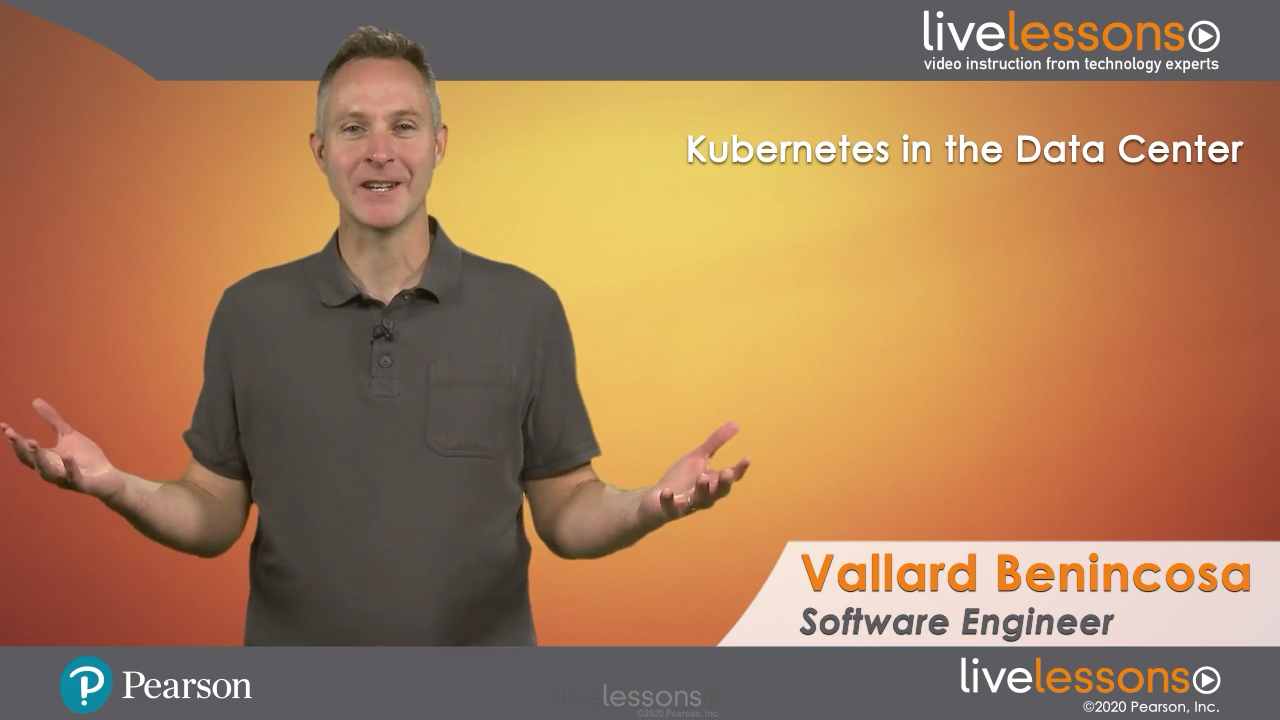Kubernetes in the Data Center LiveLessons
- By Vallard Benincosa
- Published Oct 1, 2019 by Cisco Press. Part of the LiveLessons series.
- Copyright 2020
- Edition: 1st
- Online Video
- ISBN-10: 0-13-564649-9
- ISBN-13: 978-0-13-564649-6
Register your product to gain access to bonus material or receive a coupon.
5+ Hours of Video Instruction
Overview Kubernetes in the Data Center LiveLessons focuses on using the fundamental Kubernetes components and learning how they are installed. The goal is to help you understand what the components are so when troubles arise you have the tools to be able to fix them.
The course is primarily made up of instruction and demonstrations delivered by a seasoned expert, Vallard Benincosa. Vallard, who has experience working with Cisco and IBM, is currently a senior engineer at a small startup called Zenabi. He helped develop a Kubernetes certification for the Linux foundation and has been using Kubernetes since 2015.
Kubernetes in the Data Center LiveLessons walks you through Kubernetes on prem, hardware, and Linux configurations, installation, applications storage, and networking. It also gets in to running Kubernetes, as well as monitoring and securing it. The course covers a wide gambit of technical areas and explores many of the exciting Kubernetes opensource add-ons to make your system more complete. This includes Kubernetes, Docker, Ubuntu Linux, Minio, Ceph, and many networking concepts such as overlay networks, service meshes, load balancing, ingress controllers, and proxies.
Skill LevelIntermediate/Advanced
Learn How To* Architect a Kubernetes cluster on bare metal in the data center.* Install Kubernetes on bare-metal servers.* Pick and deploy the correct overlay network for your Kubernetes cluster. You will become familiar with several options and understand the trade-offs between different solutions. * Understand and deploy distributed storage solutions with Kubernetes to offer persistent volumes. You will then use these to deploy stateful services. * Monitor and troubleshoot your Kubernetes cluster.* Run applications and take advantage of service meshes and ingress controllers. * Control user access to cluster resources.
Who Should Take This Course* People who are interested in deploying Kubernetes in enterprise data centers* People who are interested in the state of the art of container management* People who are deciding between running Kubernetes on prem or in public clouds* VMware administrators looking to see what is coming next* Networking professionals interested in understanding the coming onslaught of containerized applications
Course Requirements* Familiarity with basic shell commands * Familiarity with Docker, containers, and microservices* Familiarity with Linux system administration
About Pearson Video TrainingPearson publishes expert-led video tutorials covering a wide selection of technology topics designed to teach you the skills you need to succeed. These professional and personal technology videos feature world-leading author instructors published by your trusted technology brands: Addison Wesley, Cisco Press, Pearson IT Certification, Prentice Hall, Sams, and Que. Topics include IT Certification, Network Security, Cisco Technology, Programming, Web Development, Mobile Development, and more. Learn more about Pearson Video training at http://www.informit.com/video.
Video Lessons are available for download for offline viewing within the streaming format. Look for the green arrow in each lesson.
Table of Contents
Lesson 1: Kubernetes on PremLesson 2: Hardware ConfigurationLesson 3: Linux ConfigurationLesson 4: Kubernetes InstallationLesson 5: Application StorageLesson 6: Application Networking Lesson 7: Running KubernetesLesson 8: Kubernetes MonitoringLesson 9: Kubernetes Security
Lesson Descriptions
Lesson 1 introLesson 1, "Kubernetes on Prem," provides a brief introduction to Kubernetes, including some of its features and details about the problems it aims to solve. Several design considerations on how to deploy a Kubernetes cluster are discussed to determine the best deployment for your situation.
Lesson 2 introLesson 2, "Hardware Configuration," digs in to the nuts and bolts of what is needed and how to connect it all. This lesson talks about servers, switches, and storage, as well as configuring switches, installing operating systems, and examining different storage architectures.
Lesson 3 introLesson 3, "Linux Configuration," discusses Linux systems administration and boot strapping the cluster. This includes a discussion of all the things that should be set on your servers to prepare them for Kubernetes. Best practices, as well as some ideas about how you can make common operations easier, are shared.
Lesson 4 introLesson 4, "Kubernetes Installation," gets into the installation of Kubernetes. It explains kubeadm, the Kubernetes recommended tool to install Kubernetes, and covers the setup of Kubernetes networking, as well as an on-premise load balancer called MetalLB.
Lesson 5 introLesson 5, "Application Storage," digs in to the topic of persistence. This lesson discusses Kubernetes storage mechanisms and shows some examples of how you can use them in your own applications.
Lesson 6 introLesson 6, "Application Networking," talks about Kubernetes services, ingress controllers, ingress rules, and TLS. You learn about the service mesh project Istio, which has been embraced by many Kubernetes users, and see some examples.
Lesson 7 introLesson 7, "Running Kubernetes," discusses the different aspects of Kubernetes applications. You learn how to debug applications on Kubernetes and how to use Kubernetes with CI/CD tools. It includes several different types of workloads that can run on Kubernetes: batch jobs, CronJobs, DaemonSets, and stateful sets. A brief discussion about the world of serverless applications is included, and the lesson finishes up with horizontal pod autoscaling.
Lesson 8 introLesson 8, "Kubernetes Monitoring," tackles the various opensource tools available to keep users happy while the applications are running and monitoring the cluster. This lesson starts with metrics analytics with Prometheus and Grafana, and then moves on to logging with the EFK stack. The lesson also covers some helpful vendor tools to help keep a watchful eye on the Kubernetes clusters.
Lesson 9 introLesson 9, "Kubernetes Security," talks about role-based access control, onboarding users, trusted registries, and security best practices. This lesson shows how to secure clusters and enforces policies to keep users safe and well behaved.
Online Video
- Your Price: $239.99
- List Price: $299.99
- About this video
Video accessible from your Account page after purchase.
